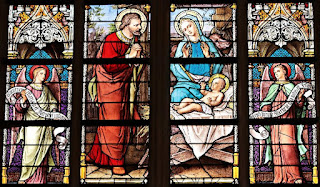St. Barnabas 33. A Christmas Message.
These past
many weeks we have taken this odyssey through the life of St. Barnabas. Now it
is Christmas time. Wouldn’t it be lovely if St. Barnabas had left us some
writing to inspire us this Christmas? To remind us of what Christmas was all
about? Well, he may have.
“In many
and various ways God spoke of old to our fathers by the prophets; but in these
last days he has spoken to us by a Son, whom he appointed the heir of all
things, through whom also he created the world. He reflects the glory of God
and bears the very stamp of his nature, upholding the universe by his word of
power.” Now here’s the Christmas part: the Son who is God also “partook of the
same nature” as all of us children of God. That’s Christmas, God come in the
form of our human flesh. Why? “That through death he might destroy him who has
the power of death, that is, the devil, and deliver [us].” Say it again, “He
had to be made like his brethren in every respect so that he might become a
merciful and faithful high priest in the service of God, to make expiation for
the sins of the people.”
That’s Christmas. God taking on human form, our flesh, body and soul, in Baby Jesus. Why? To deliver us from the devil’s grasp, from eternal death. The choice whether to accept or reject it is ours. Christmas is a great time to reflect, meditate, and re-evaluate.
Now if the
words quoted above sound familiar, yes, they are from the Book of Hebrews(1:1-3; 2:14-17). Didn’t St. Paul write that book? Perhaps, but we actually
don’t know. For about the first 200+ years of the Church, the believers in the
West thought Barnabas wrote it.
There has
never been serious doubt about Hebrews’ inspiration, but there has been frequent
doubt about authorship. St. Clement of Alexandria (roughly 150-211 AD), in the
Eastern Church, believed it was either written by Paul or a disciple of his.
Tertullian (roughly, 155-225 AD), in the Western Church, understood without any
doubt that Barnabas wrote it. [1] Two centuries later, St. John Chrysostom (about
344-407 AD) in the Eastern Church, accepted Paul as the author, and in the
Western church, St. Augustine (354-430 AC) and St. Jerome (about 349-420 AD)
also accepted Paul as the author (they did communicate together). There are
good reasons to still consider that Barnabas may be the author. [2]
So we can meditate on these words from the Book of Hebrews as though maybe they came from this extraordinary Apostle, St. Barnabas. We can meditate on what he may be speaking to us today about the meaning of Christmas. In fact, if we read more passages, we may be hearing just how this “Son of Encouragement” might encourage us today.
Our Lady of Lourdes Catholic Church is located in California City, CA. Visit our website at ollcalcity.org.
Dibby Allan Green has a BA in Religious Studies (Westmont College, 1978) and MA in Theology (Augustine Institute, 2019), is a lay Catholic hermit, and a parishioner of Our Lady of Lourdes Parish.

